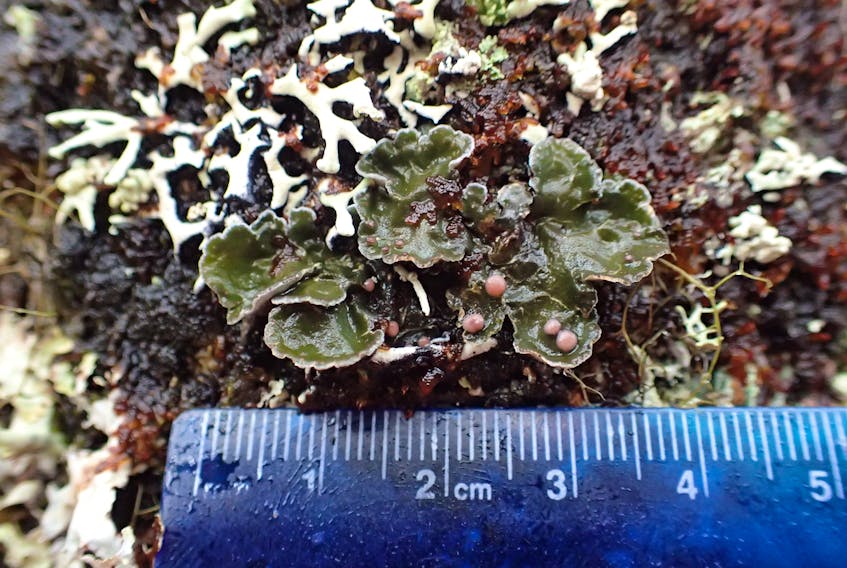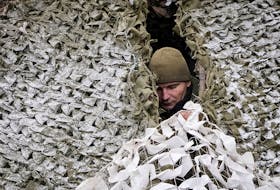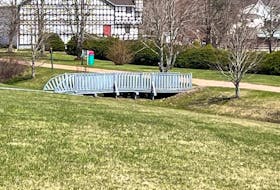Newfoundland and Labrador Hydro proposed a new transmission line from Bay d’Espoir to the Western Avalon, but before the line started the environmental assessment process, the work required for the project was already underway. And the work is continuing today, long after the line is built and in operation.
The power line is also known as TL-267. As with all major projects, the work required is extensive and detailed. It begins before a plan is submitted for environmental assessment (this project was registered in July 2015) and continues through the construction, if approved, then on into post-construction monitoring.

You need to determine if plans are followed and then what is happening in the local environment.
In the case of this power line, one of the specific concerns was any presence of rare species along the planned route. One of the discoveries was boreal felt lichen (erioderma pedicellatum).
Boreal felt lichen are listed as a vulnerable species on the province’s endangered species list (species are added as “vulnerable,” “threatened” or “endangered”). Examples of other “vulnerable” species include the American eel (Anguilla rostrata), mountain fern (Thelypteris quelpaertensis) and polar bear (Ursus maritimus).
The lichen enjoy a specific, damp microclimate, and grow attached to old-growth trees. Being quite small, they’re easy to miss and not likely to be identified by someone not familiar with mycology, or the even more niche area of lichenology.
“Something’s on a tree and if someone goes and harvests wood (nearby) I’m sure they’re saying well that’s whatever, bark on a tree, whereas a lichenologist is looking and saying well that’s boreal felt lichen. That’s on our endangered species list,” said N.L. Hydro’s manager for environmental services Rob Healey in a recent interview.
In early assessment work, Newfoundland and Labrador Hydro hired consultants for different pieces of assessment work. A consultant employing mycologists assessed the 188-kilometre line route and, in the pre-construction period, the specialists moved from mapping possible habitat in an office to physically walking the line area.
It meant moving out in teams of at least two from any existing woods roads, corridors, or beaten paths at times. Consultants recorded all manner of species along the proposed route, and the environmental assessment process included government approval for a detailed “rare plant and lichen protection and monitoring plan” dictating next steps.
Specialist logs established exact locations – stands of trees, down to numbered tacks on trees in those stands.
“Once the line is assessed we’ll have these locations on the line that have to be transplanted. We’ll find a suitable location off the right of way, take the plants — the lichenologist will take them, dissect them, remove them, moisten them, make sure they’re going to survive — bring them to the transplant locations, GPS it, and start marking the ones they’ve transplanted,” Healey said.
The lichen is placed on a carefully identified receptor tree, as per instructions from the regulator. Wire is wrapped around the lichen and jutting bark to hold it against the tree surface.
Every step in the process is first approved by the Department of Environment and Conservation.
“Once we do this transplant we have to go back and monitor year after year, so that’s extremely important,” Healey said.
That follow-up is also not by Nalcor or N.L. Hydro staff, but by consultants.

In the case of the Bay d’Espoir line, LGL Limited was hired for the lichen movement, including a year of monitoring, covering the construction period. Another environmental consultant, SEM Ltd., was contracted for four years of post-construction monitoring.
Another round of surveying the lichen is set for this fall.
So far, there are no reports of mass mortality. The lichen are slow to establish and make small gains — nothing like grass on a front lawn.
“They’re not going to engulf the tree. You’re talking small bits of movement,” Healey said.
At this point, more than four years after the power line project was formally proposed, there are no declarations yet of “success.”
And the lichen were just one concern.
“On TL-267 there was water course crossings we had to protect. We’re going to go in now and actually do remediation on those. There’s caribou monitoring, there’s caribou going around with collars on them that we have to make sure we’re following and will have to be removed in time as follow-up based on our commitments,” Healey said.
RELATED:









